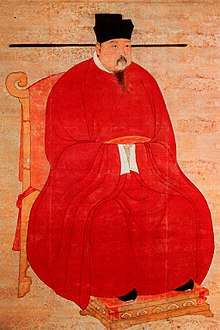Emperor Zhenzong
| Emperor Zhenzong of Song 宋真宗 | |||||||||||||
|---|---|---|---|---|---|---|---|---|---|---|---|---|---|
 | |||||||||||||
| Emperor of the Song dynasty | |||||||||||||
| Reign | 8 May 997 – 23 March 1022 | ||||||||||||
| Coronation | 8 May 997 | ||||||||||||
| Predecessor | Emperor Taizong | ||||||||||||
| Successor | Emperor Renzong | ||||||||||||
| Born |
Zhao Dechang (968–983) Zhao Yuanxiu (983–986) Zhao Yuankan (986–995) Zhao Heng (995–1022) 23 December 968 | ||||||||||||
| Died | 23 March 1022 (aged 53) | ||||||||||||
| |||||||||||||
| House | House of Zhao | ||||||||||||
| Father | Emperor Taizong | ||||||||||||
| Mother | Consort Li | ||||||||||||
| Emperor Zhenzong of Song | |||||||
| Chinese | 宋真宗 | ||||||
|---|---|---|---|---|---|---|---|
| Literal meaning | "True Ancestor of the Song" | ||||||
| |||||||
| Zhao Dechang | |||||||
| Traditional Chinese | 趙德昌 | ||||||
| Simplified Chinese | 赵德昌 | ||||||
| |||||||
| Zhao Yuanxiu | |||||||
| Traditional Chinese | 趙元休 | ||||||
| Simplified Chinese | 赵元休 | ||||||
| |||||||
| Zhao Yuankan | |||||||
| Traditional Chinese | 趙元侃 | ||||||
| Simplified Chinese | 赵元侃 | ||||||
| |||||||
| Zhao Heng | |||||||
| Traditional Chinese | 趙恆 | ||||||
| Simplified Chinese | 赵恒 | ||||||
| |||||||
Emperor Zhenzong of Song (23 December 968 – 23 March 1022), personal name Zhao Heng, was the third emperor of the Song dynasty in China. He reigned from 997 to his death in 1022. His personal name was originally Zhao Dechang, but was changed to Zhao Yuanxiu in 983, Zhao Yuankan in 986, and finally Zhao Heng in 995. He was the third son of his predecessor, Emperor Taizong, and was succeeded by his sixth son, Emperor Renzong.
Emperor Zhenzong's reign was noted for the consolidation of power and the strengthening of the Song Empire. The empire prospered, and its military might was further reinforced. However, it would also mark the beginning of a foreign policy towards the Khitan-led Liao dynasty in the north that would ultimately result in humiliation.
In 1004, the Khitans waged war against the Song Empire. Emperor Zhenzong, leading his army, struck back at the Khitans. Despite initial successes, in 1005, Emperor Zhenzong concluded the Shanyuan Treaty. The treaty resulted in over a century of peace, but at the price of the Song Empire agreeing to an inferior position to the Liao Empire, and also agreeing to pay an annual tribute of 100,000 ounces of silver and over 200,000 bolts of silk. The admission of inferiority would come to plague the foreign affairs of the Song Empire, while the payments slowly depleted the empire's coffers.
He was responsible for ordering the shipment of 30,000 bushels of quick-maturing rice seed from the Fujian Province to the lower Yangtze basin in 1011–1012, improving agriculture.
Emperor Zhenzong stressed the importance of Taoism at his imperial court. It was during his reign that the so-called Heavenly Texts, which glorified the Zhao family, were allegedly discovered. This was followed up by imperial sacrificial ceremonies carried out at Mount Tai. From 1013 to 1015, the emperor issued official decrees deifying the Jade Emperor as the highest ruler of Heaven.[1]
Champa rice was introduced to China from Champa during Emperor Zhenzong's reign.
In 1020, Emperor Zhenzong became affected by an illness which was to cause his death two years later and unable to handle the affairs of state. By this time, Zhenzong’s wife Empress Liu was already established as power behind the throne and handled the affairs of state. She continued to act unofficially as regent of China for the two remaining years of Zhenzong’s life.
Zhenzong died in 1022 of the foresaid illness. He was succeeded by his 4th son, Zhao Zhen who took the throne as Emperor Renzong.
Archaeology
A number of Chinese artifacts dating from the Tang dynasty and Song dynasty, some of which had been owned by Emperor Zhenzong were excavated and then came into the hands of the Kuomintang general Ma Hongkui, who refused to publicise the findings. Among the artifacts were a white marble tablet from the Tang dynasty, gold nails, and bands made out of metal. It was not until after Ma died, that his wife went to Taiwan in 1971 from the United States to bring the artifacts to Chiang Kai-shek, who turned them over to the National Palace Museum.[2]
Family
- Parents:
- Zhao Jiong (太宗 趙炅; 939 – 997)
- Posthumous empress Li (元德皇后 李氏; 943 – 997)
- Consorts and Issue:
- Posthumous empress Pan (章懷皇后 潘氏; 968 – 989)
- Empress Guo (章穆皇后 郭氏; 975 – 1007)
- Zhao You (悼獻皇太子 趙佑; 995 – 1003)
- Unnamed son
- Unnamed son
- Empress Liu (章獻皇后 劉娥; 968 – 1033), personal name E
- Posthumous empress Li (章懿皇后 李氏; 987 – 1032)
- Zhao Zhen (仁宗 趙禎; 1010 – 1063)
- Princess Jingyi (靜一帝姬)
- Posthumous empress Yang (章惠皇后 楊氏; 984 – 1036)
- Second rank consort Shen (昭靜貴妃 沈氏; 994 – 1076)
- Second rank consort Du (貴妃 杜瓊真; d. 1046), personal name Qiongzhen
- Princess Zhaohuai (昭懷帝姬 趙志衝; d. 1047), personal name Zhichong
- Unknown
- Zhao Ti (溫王 趙禔)
- Zhao Zhi (昌王 趙只)
- Zhao Zhi (信王 趙祉)
- Zhao Qi (欽王 趙祈)
See also
References
- ↑ Jonathan D. Spence. God's Chinese Son. New York 1996. p.42
- ↑ China archeology and art digest, Volume 3, Issue 4. Art Text (HK) Ltd. 2000. p. 354.
Emperor Zhenzong House of Zhao (960–1279) Born: 997 Died: 1022 | ||
| Regnal titles | ||
|---|---|---|
| Preceded by Emperor Taizong |
Emperor of the Song Dynasty 997–1022 |
Succeeded by Emperor Renzong |
| Emperor of China 997–1022 | ||